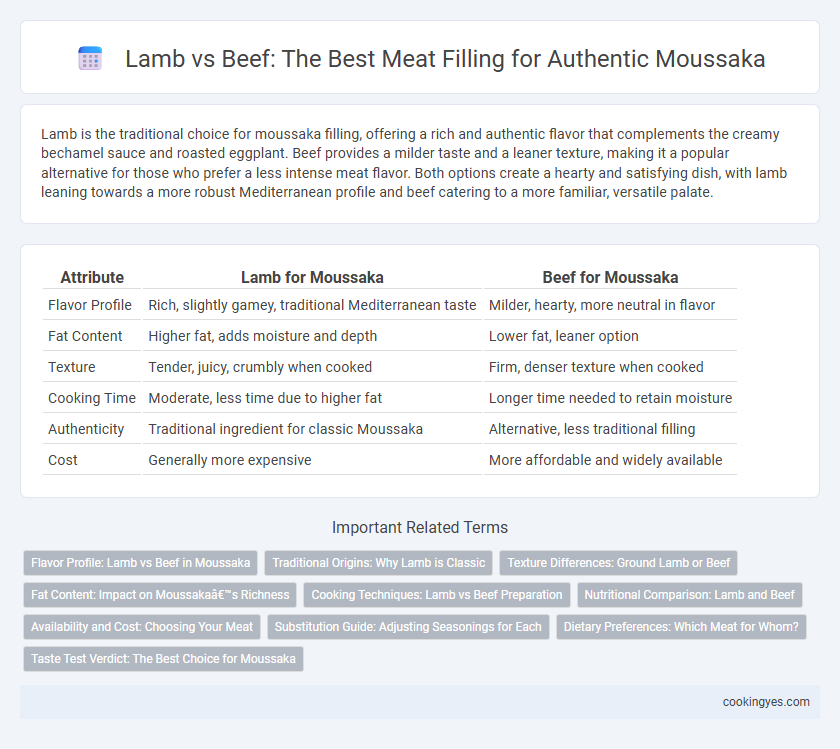Lamb is the traditional choice for moussaka filling, offering a rich and authentic flavor that complements the creamy bechamel sauce and roasted eggplant. Beef provides a milder taste and a leaner texture, making it a popular alternative for those who prefer a less intense meat flavor. Both options create a hearty and satisfying dish, with lamb leaning towards a more robust Mediterranean profile and beef catering to a more familiar, versatile palate.
Table of Comparison
| Attribute | Lamb for Moussaka | Beef for Moussaka |
|---|---|---|
| Flavor Profile | Rich, slightly gamey, traditional Mediterranean taste | Milder, hearty, more neutral in flavor |
| Fat Content | Higher fat, adds moisture and depth | Lower fat, leaner option |
| Texture | Tender, juicy, crumbly when cooked | Firm, denser texture when cooked |
| Cooking Time | Moderate, less time due to higher fat | Longer time needed to retain moisture |
| Authenticity | Traditional ingredient for classic Moussaka | Alternative, less traditional filling |
| Cost | Generally more expensive | More affordable and widely available |
Flavor Profile: Lamb vs Beef in Moussaka
Lamb offers a rich, earthy flavor with a slightly gamey undertone that enhances the traditional Mediterranean character of moussaka. Beef provides a milder, heartier taste that creates a more neutral base, allowing spices and tomato sauce to stand out. Choosing lamb preserves the authenticity and depth of the dish, while beef delivers a familiar and less intense flavor profile.
Traditional Origins: Why Lamb is Classic
Lamb remains the classic choice for traditional moussaka filling due to its deep-rooted association with Mediterranean and Middle Eastern culinary traditions, where the dish originated. Rich in flavor and tender fat content, lamb imparts a distinctive savory richness that complements the layers of eggplant, bechamel sauce, and spices characteristic of authentic moussaka recipes from Greece and Turkey. While beef is commonly used in modern adaptations for its milder taste and availability, lamb's robust profile preserves the heritage and authenticity of this iconic regional casserole.
Texture Differences: Ground Lamb or Beef
Ground lamb provides a richer, fattier texture that enhances the moistness and depth of flavor in Moussaka, contributing to a tender and slightly crumbly filling. Ground beef offers a leaner, firmer texture that holds shape well during baking, resulting in a denser and more uniform filling. The choice between lamb and beef significantly impacts the overall mouthfeel and consistency of the traditional Greek casserole.
Fat Content: Impact on Moussaka’s Richness
Lamb contains a higher fat content than beef, which significantly enhances the richness and moisture of Moussaka's filling. The natural fats in lamb melt during cooking, providing a succulent texture and deeper flavor that complements the creamy bechamel sauce. In contrast, leaner beef results in a less fatty filling, offering a lighter, less indulgent Moussaka experience.
Cooking Techniques: Lamb vs Beef Preparation
Lamb for moussaka filling benefits from slow simmering to tenderize its naturally rich and fatty texture, which enhances the dish's authentic Mediterranean flavor profile. Beef requires careful browning at higher heat to develop a deeper umami taste, followed by gentle simmering to prevent toughness while absorbing spice blends. Both meats respond well to layering with tomato sauce and aromatic herbs, but lamb's inherent fat content demands less additional oil during cooking compared to leaner beef.
Nutritional Comparison: Lamb and Beef
Lamb and beef both provide rich protein sources for moussaka, but lamb offers higher levels of omega-3 fatty acids and conjugated linoleic acid (CLA), which support heart health. Beef contains more iron and zinc per serving, essential for immune function and oxygen transport. Calorie-wise, lamb generally has slightly higher fat content, contributing to a more robust flavor but increased saturated fat intake compared to lean beef options.
Availability and Cost: Choosing Your Meat
Lamb is traditionally preferred for authentic moussaka due to its rich flavor, but it tends to be more expensive and less widely available than beef, especially in regions outside the Mediterranean. Beef provides a cost-effective and more accessible alternative without compromising too much on taste, making it a popular choice in many markets. Availability and budget often drive the decision between lamb and beef, influencing the final taste and authenticity of the dish.
Substitution Guide: Adjusting Seasonings for Each
Lamb offers a rich, earthy flavor that pairs well with robust spices like cinnamon, allspice, and nutmeg, enhancing traditional Moussaka seasonings. Beef, being milder and leaner, benefits from a bolder seasoning profile with extra garlic, oregano, and a touch of smoked paprika to replicate the depth lamb naturally provides. Adjusting spice ratios ensures the filling maintains authentic Mediterranean taste regardless of whether lamb or beef is used.
Dietary Preferences: Which Meat for Whom?
Lamb is rich in omega-3 fatty acids and vitamin B12, making it ideal for those seeking higher nutrient density in their Moussaka filling. Beef offers a leaner alternative with lower saturated fat levels, appealing to individuals focused on heart-healthy diets. Mediterranean cuisine often favors lamb for its robust flavor, while beef suits those preferring a milder, more neutral taste.
Taste Test Verdict: The Best Choice for Moussaka
Lamb offers a richer, more authentic flavor profile that enhances the traditional taste of moussaka, thanks to its slightly gamey and robust meatiness. Beef provides a milder, less fatty alternative, making it suitable for those preferring a subtler taste, but often lacks the depth that lamb imparts to the dish. Taste test verdicts consistently favor lamb as the best choice for moussaka filling, highlighting its ability to elevate the overall savory experience.
Lamb vs Beef for Moussaka filling Infographic

 cookingyes.com
cookingyes.com